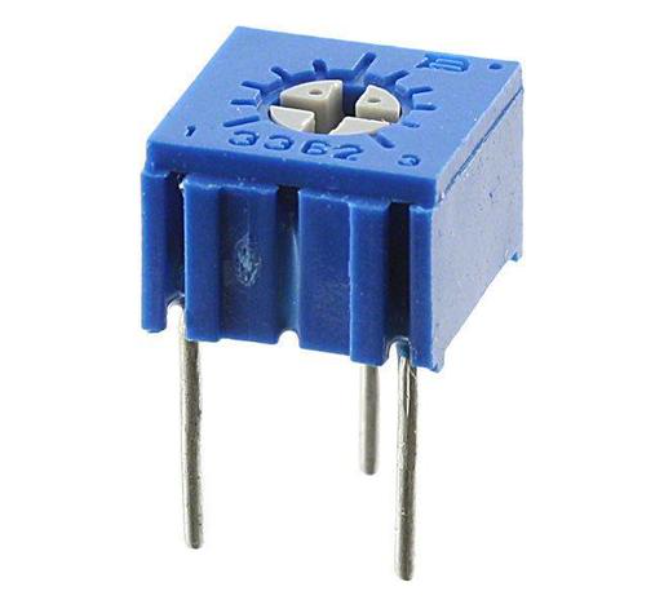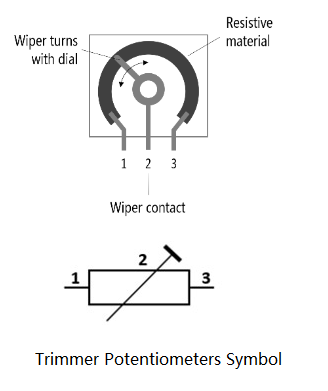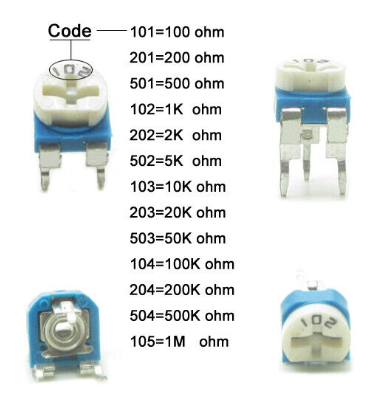Trimmer Potentiometers: Pinout, Symbol & Codes

What Are Trimmer Potentiometers?
A trimmer potentiometer is an electronic component also known as a variable resistor, user adjustable resistor, or direct analog-to-digital converter (DAC). Typically found on PCBs, they are often used to adjust the performance of a circuit after manufacturing. It allows its resistance value to be adjusted either manually or through a mechanical system for calibration, regulation and control in the circuit. The design and characteristics of the trimmer potentiometer are similar to that of the potentiometer, but it is smaller and more accurate.
Trimmer potentiometers are three-terminal devices that allow small adjustment resistances. Its basic structure consists of three main parts: the rotation axis, the resistance element and the pin. Its working principle is based on a rotating resistor and a rotating knob. When the knob is rotated, the sliding contacts in the resistor also move, which changes the resistance value at different locations in the resistor, which in turn affects the current and voltage in the circuit. Although this adjustment range is small, the adjustment accuracy is very high, making fine tuning potentiometers especially important in circuits that require precise adjustment. The components are manually adjusted, which means the user can fine-tune them using a small screwdriver.

Fine tuning potentiometers do not need to be adjusted as often as ordinary potentiometers. Once set, they usually remain in that position for the remainder of the circuit's life. You can find them in devices like radios, which adjust the frequency, or in amplifiers to set the gain level. Their precision makes them essential for calibration purposes.
Trimmer Potentiometers Pinout
It has three pins, and understanding the pinout is essential for proper usage.

l Pin 1 (Input/End 1):
This pin is connected to one end of the resistive track inside the potentiometer. It is usually connected to the input voltage or ground depending on the configuration.
l Pin 2 (Wiper/Output):
The wiper moves along the resistive track, changing the resistance. This pin outputs a voltage that depends on the position of the wiper, making it the adjustable output.
It’s often connected to the circuit where variable resistance or voltage adjustment is required.
l Pin 3 (Input/End 2):
This pin is connected to the other end of the resistive track. Like Pin 1, it can be connected to ground or the input voltage depending on the circuit design.
The voltage difference between pin 1 and pin 2 determines the resistance value set by the trimmer. By adjusting the wiper, you can set the desired output, which then fine-tunes the circuit.
Trimmer Potentiometers Symbol
In circuit diagrams, trimmer potentiometers are represented with a unique symbol. It’s usually drawn as a standard resistor symbol, but with an arrow across the body indicating the adjustment mechanism. The arrow represents the adjustable wiper that changes resistance as it moves along the resistive path. In many circuit diagrams, the symbol looks like a regular potentiometer with a diagonal arrow pointing at the resistor portion.
l Resistor symbol: Two horizontal lines with a zigzag between them, representing the resistive element.
l Three terminals - The left and right ends represent the fixed resistance terminals (Pins 1 and 3). The middle connection, shown as an arrow pointing to the resistor, represents the adjustable wiper (Pin 2).
l Diagonal arrow: A diagonal line or arrow across the resistor indicates that it is a variable component (adjustable).

Trimmer Potentiometers Codes
Trimmer potentiometers typically have codes to indicate their resistance value, tolerance, and other specifications. These codes help identify the characteristics of the trimmer without needing to measure it. Below are the most common types of codes:
1. Resistance Code
Trimmer potentiometers often use a 3-digit code to represent the resistance value, similar to resistors. The first two digits represent the significant figures, and the third digit is the multiplier. For example, a code of 103 means 10,000Ω (10 followed by 3 zeros). A code of 472 means 4.7KΩ (47 followed by 2 zeros).

2. Tolerance Code
The tolerance of a trimmer potentiometer is usually expressed as a percentage and may be printed alongside the resistance code. Common tolerances include ±10%, ±20%, etc.
3. Adjustment Turns Code
Some trimmer potentiometers indicate the number of adjustment turns required to move the wiper from one end of the track to the other. A typical code might be:
l 1T for single-turn trimmers.
l 25T for multi-turn trimmers (e.g., 25-turn).
4. Type Code
Manufacturers often use codes to describe the type of trimmer potentiometer (e.g., through-hole or surface mount, single-turn or multi-turn). For example, 3296 is a common code for a 25-turn, multi-turn trimmer potentiometer.
5. Resistance Taper (Optional)
Some trimmer potentiometers may include information about the taper (linear or logarithmic). Most trimmers use a linear taper (denoted by B).
How Do You Measure a Potentiometer on a Trimmer?
Measuring a trimmer potentiometer involves checking its resistance and verifying the wiper's position relative to the end terminals. You can do this using a digital multimeter (DMM) set to the resistance (ohms) mode.
1. Prepare the Multimeter
Set your digital multimeter (DMM) to the resistance measurement mode (Ω). Ensure that the trimmer potentiometer is disconnected from any circuit to avoid interference and ensure an accurate reading.
2. Measure Total Resistance (Between End Pins)
Place one probe on Pin 1 and the other on Pin 3, which are the two end pins of the trimmer potentiometer. The multimeter should display the total resistance value of the potentiometer, which should match the nominal resistance indicated by the code on the component.
3. Measure Resistance Between Wiper and End Pins (Adjustable Resistance)
Place one probe on Pin 1 and the other on Pin 2, the wiper pin. Adjust the trimmer’s wiper using a screwdriver while observing the multimeter. The resistance should change smoothly with the wiper’s position. Repeat this measurement between Pin 3 and Pin 2 to verify the variable resistance behavior.
4. Check for Smooth Operation
Ensure that as you adjust the wiper, the resistance changes smoothly without sudden jumps or erratic fluctuations. If the readings are unstable or inconsistent, the trimmer potentiometer may be faulty or require cleaning.
What is the Difference Between A and C Potentiometers?
When it comes to potentiometers, the terms "A" and "C" refer to their taper, or how resistance changes as the wiper moves.
A-Taper Potentiometers (Linear Taper)
The resistance changes linearly with the rotation of the wiper. This means that the resistance increases or decreases at a consistent rate as you turn the knob or adjust the wiper. For example, turning the wiper halfway will result in a resistance that is approximately half of the total resistance between the two end terminals.
C-Taper Potentiometers (Logarithmic or Audio Taper)
The resistance changes logarithmically with the rotation of the wiper. This means that the resistance changes more rapidly at one end of the rotation and more slowly at the other end. This type of taper is often used in audio applications. For instance, in an audio volume control, turning the knob slightly may produce a noticeable change in volume, while turning it further results in a more gradual increase in volume.
What Is the Purpose of a Potentiometer?
A potentiometer serves as a variable resistor, allowing you to adjust voltage and current in a circuit. Trimmer potentiometers do this on a smaller, more precise scale. Their main purpose is to fine-tune a circuit after it’s built. Whether it's adjusting the brightness of an LED or calibrating a sensor, trimpots help bring a circuit into optimal performance. In addition to this, they have some others functions:
l Adjusting voltage levels
l Controlling signal levels
l Calibration and tuning
l Setting reference values
l Variable resistors
In devices like radios or amplifiers, they allow for subtle adjustments that improve overall functionality. Without them, you’d need to rebuild the circuit every time a slight change was needed.
How Do I Know What Potentiometer I Need?
Selecting the right potentiometer for your application involves considering several key factors to ensure it meets your specific needs. You can try to following steps to do:
1. Determine the Resistance Range
Identify the required resistance value for your application, as specified by the circuit design or component requirements. Ensure that the potentiometer’s resistance range includes this value to ensure proper functionality.
2. Choose the Taper
Decide between a linear taper (A) for a consistent resistance change or a logarithmic taper (C) for a non-linear response. Linear tapers are suitable for applications requiring direct proportional adjustments, while logarithmic tapers are ideal for audio controls where volume perception is logarithmic.
3. Decide on the Type
Select the type of potentiometer that fits your needs, such as a rotary potentiometer for manual adjustments, a slide potentiometer for sliding controls, or a trimmer potentiometer for fine-tuning and calibration within circuits.
4. Check the Physical Size and Mounting Style
Ensure the potentiometer fits physically in your design by considering its dimensions and mounting type, such as through-hole or surface-mount. The mounting style should align with your circuit board design and application.
5. Consider the Power Rating
Verify the potentiometer’s power rating to ensure it can handle the power dissipated in your application without risk of overheating or damage.
6. Evaluate the Tolerance
Look at the tolerance specification of the potentiometer, which indicates how much the actual resistance may vary from the stated value. Choose a potentiometer with the appropriate tolerance based on the precision needed for your application.
7. Review the Mechanical Life
Consider the potentiometer’s mechanical life, which refers to the number of adjustment cycles it can endure. For applications with frequent adjustments, select a potentiometer with a high mechanical life to ensure durability.
8. Look at the Environmental Factors
Assess the environmental conditions where the potentiometer will be used. For harsh environments, opt for potentiometers with adequate environmental protection, such as sealed or ruggedized types, to ensure long-term reliability.
Trimpot vs Potentiometer
A trimpot (trimmer potentiometer) is a compact, precision-adjustable component designed for infrequent adjustments. Typically used for calibration and fine-tuning within circuits, it is adjusted using a small screwdriver. Trimpots are ideal for settings that need to be configured during manufacturing or setup and are generally not intended for frequent use. A trimpot (trimmer potentiometer) is a compact, precision-adjustable component designed for infrequent adjustments. Typically used for calibration and fine-tuning within circuits, it is adjusted using a small screwdriver. Trimpots are ideal for settings that need to be configured during manufacturing or setup and are generally not intended for frequent use.
In contrast, a potentiometer is designed for regular user interaction and frequent adjustments. Available in various sizes and types, such as rotary or slide, potentiometers are commonly used in applications like volume controls and tone adjustments. Potentiometers are used in everyday applications such as volume controls, tone controls, and variable resistors in various devices. They are suitable for applications where users need to frequently change settings.
FAQs
1. What are the common types of trimmer potentiometers?
Common types of trimmer potentiometers include single-turn, multi-turn, and digital trimmers. Single-turn trimmers allow for a full adjustment in one turn, while multi-turn trimmers provide finer control with several turns.
2. How does a trimmer potentiometer work?
A trimmer potentiometer works by varying the resistance between its end pins through the movement of its wiper pin. Turning a small screwdriver adjusts the wiper's position along a resistive track, changing the resistance between the wiper and the end pins.
3. How do I adjust a trimmer potentiometer?
To adjust a trimmer potentiometer, use a small screwdriver to turn the adjustment screw. This will move the wiper pin along the resistive track, changing the resistance.
4. How do I choose the right trimmer potentiometer for my application?
Choose a trimmer potentiometer based on the required resistance range, tolerance, physical size, and adjustment type. Consider the application’s need for precision and the environmental conditions it will be exposed to.
5. Can trimmer potentiometers be replaced with regular potentiometers?
While regular potentiometers can sometimes replace trimmer potentiometers, they are designed for different purposes. Regular potentiometers are meant for frequent user adjustments, while trimmer potentiometers are used for settings that are adjusted less often.
Statement
All articles (images, texts, audio) on this site are uploaded and shared by users, or integrated from relevant internet sources, only for user's learning. If your rights are violated, please contact the administrator to delete! Link to this article: https://www.jinftry.com
GRM0335C2A820JA01J, GRM1555C1H560FA01D, GRM2166S1H270JZ01D, GRM31BR72E683KW01L, GSA15DRMD-S288, GTCL01F32-22S-027-B30, GTCR36-750M-R10, GTS030-20-3S, GTS07R36-5SX, GTT38A-TPR-BLH-B0-H1-CT-VPT, GW-JCLMS1-EC-GTHP-5L7N-L1N2, H16WD6075, HBC08DRTI-S93, HBC20DRYS, HDWM-20-57-S-D-345-SM-A-P, HEDL-5500-G12, HHV-50FT-52-8M87, HM17-664101LF, HMC1048LC3BTR-R5, HMC565-SX, HPS0631503JKB15, HSC10DRTI, HSC18DRYH-S13, HZ4B3TD-E, IEGF66-32427-3-V, IHLW5050CEER1R5M01, IHSM3825EB3R3L, IPB075N04LG, IRF6810STR1PBF, IRFS23N20D, IRG7PH50UPBF, IS42VM16800G-6BLI, ISO7831FDW, JBXFD2J02FCSDSR, JCK3012D05, JTP02RE-16-35P-LC, KF0970500000G, KJB6T25J61SB, KJB7T23F21JD, KNP1WSJT-52-0R75, KO119A7325, KTR10EZPJ151, L06P700S05, L77TWA11W1SESV4FA203, LED75W-200-C0350-D, LFG480303SQDINR, LKS1J182MESY, LM2901PWRG4, LM337BD2TR4G, LM4040DIM7-2-5-NOPB, LP2951CN-3-3G, LP2980IM5X-4-7, LQW18CN15NJ00D, LT6238HGN-TRPBF, LTC2637CDE-HMI12-TRPBF, LTC3425EUH-TRPBF, LY2-0-DC6, M1330-04K, M39003-01-2250-HSD, M39003-09-3054, M52-5051445, M55342E02B432ARWI, M55342E04B625ART5, M55342E06B82A0ST5, M55342E12B10B0SWP, M55342K02B453ARWS, M55342K03B309BRWS, MAL210657103E3, MAX17605ASA, MAX3212EAI-T, MAX3227EEAE-T, MAX339ESE-T, MAX6390XS26D4, MAX8632ETI-T, MAX8922ETB-T, MB90522BPFV-GS-143-BND, MB96F635RBPMC-GSAE1, MBA02040C6194FRP00, MC22FA202J-TF, MC74ACT139DTR2G, MC78M05CDTT5, MCC56-14, MCT06030C4303FP500, MDM-21PSK, ME30A2402C01, MEA1D0505SC, MF0207FRD52-698R, MFR-12FRF52-1R87, MFR100FRE52-1K78, MFR1WSDBD52-250R, MFR2WSFTF52-27K, MFR50SDBE52-5K62, MI-222-IW-F4, MI-27W-MY-S, MINIHAM1C12, MM3Z5V1-AQ, MMBZ5251BS-7, MMP100FRF13K3, MMSZ5248BS-7-F, MNR18ERAPJ300, MP6-1V-1V-1W-1W-4NN-00, MRF1-6-5-6-PJ-59U, MRF8S18120HR3, MS23ANA03, MS27466T15B5A_156, MS27473T10F35P-CGMSS3, MS27656T25B1S, MS3100E16-11S_529, MS3100F2212S, MS3100R20-4S_529, MS3126F12-10PW-LC, MS46SR-14-870-Q1-R-NC-AN, MS46SR-30-870-Q1-10X-10R-NC-FP, MS4800B-20-0680-10X-10R-RM1, MSMLJ100AE3, MT41K256M16TW-125-P, MTCB1R-010-010-01, MTV1-2PS, MXO45-2C-1M0000, MXR-8PA-3PB-71, N-255MG, NJW4182U3-33-TE1, NMH0515DC, NSVBC144EPDXV6T1G, NTP75N03R, OPA234E-250G4, OPA4991QPWRQ1, OPB891L51Z, OSTOQ231250, P1206Z1002FBW, P1330-563J, P51-2000-S-B-M12-4-5OVP-000-000, P51-500-A-F-D-20MA-000-000, P51-750-S-H-D-4-5OVP-000-000, P51-750-S-W-P-4-5OVP-000-000, PA10, PCIE-098-02-S-D-RA, PE2010JKM070R05L, PF0698-684NLT, PHP00805H3521BBT1, PIC16F720T-I-ML, PIC16LC620-04E-SO, PK2-56R-T, PL1368, PM1210-330J-RC, PPT2-0100GKX2VS, PT06P-20-16P, PT1000A50, PT7C5038A1-2GDE, PTF65470R00FZBF, PTH03030WAZT_95, PZU20BL-315, Q8R7BXXG02E, R12P209D, R5FBLKBLKFF0, R6202450XX00, R7S921043VCBG-BC0, RBM43DCCH, RC0603FR-0715R4L, RC3216F1474CS, RCEC7505000JB, RCL061261K9FKEA, RCP0603W1K00GEA, RCS0402360RJNED, REG101NA-5-250, RER75FR453RCSL, RF073M2STR, RG1608N-3091-C-T5, RK73G1ETTP1873F, RK73H2BTTD4222D, RLP021R540FA20, RLR05C1503GSRE619, RLR05C2673FSBSL, RLR05C3322FSBSL19, RLR05C5R10GSRE8, RLR05C97R6FSBSL, RLR07C10R0FSRE8, RLR07C3161FSB14, RLR07C3743FPRE7, RLR07C4221FSR36, RLR07C9761GSB14, RLR20C1651FRRE8, RLR20C5230FSRSL, RLR20C7500FSRE5, RLR32C2700GPB14, RMB1054R700JR15, RMC18DTEI, RMCF0402JT15R0, RMCF2512FT1M02, RMCF2512JT13K0, RN4904-LXHF-CT, RN50C2941FB14, RN50E3090BRE6, RN55C1112BB14, RN55C6571BBSL, RN55C74R1BB14, RN55D1604FRE6, RN60C2460BB14, RN60E3322FB14, RN65C3572FRSL, RN732ATTD3401C10, RN732BTTD11R7F50, RN732BTTD1601C10, RN732BTTD93R1D100, RN73H1ETTP2430F10, RN73H1ETTP2461B25, RN73H1ETTP9311C50, RN73H1JTTD1181A25, RN73H1JTTD2101B50, RN73H1JTTD7060A05, RN73H2ATTD1094F25, RN73H2ATTD2290B50, RN73H2ATTD2672B50, RN73H2ATTD3442C25, RN73H2ATTD4071C50, RN73H2ATTD8061C50, RN73H2BTTD5760C50, RN73H2BTTD6343F100, RN73H2ETTD2132B50, RN73H2ETTD2700D10, RN73H2ETTD3093C10, RN73H2ETTD8451A25, RN73R1ETTP2740F10, RN73R1JTTD2323C50, RN73R1JTTD3361B25, RN73R1JTTD47R0F10, RN73R1JTTD7322B25, RN73R1JTTD8160A25, RN73R2ATTD1002D100, RN73R2ATTD4021B50, RN73R2BTTD3441A05, RN73R2BTTD4531F25, RN73R2ETTD1092D10, RN73R2ETTD1372D50, RN73R2ETTD2741C10, RN73R2ETTD3573F10, RNC50H1433FSRSL31, RNC50H1780FRB14, RNC50H1983BSRE6, RNC50H3361BSRSL, RNC50H5422DSB14, RNC50K2740FPR36, RNC55H2741FSRE7, RNC55H2743FRB14, RNC55H62R6BSBSL, RNC55J1270BSRE5, RNC55J1474BSRE6, RNC55J2491BSRE865, RNC55K3401FPRE6, RNC60H3241FSB14, RNC60J59R7BSB14, RNC65H1960FRRE7, RNC65H6652FRRE6, RNCF0805BKT2K00, RNCF2010BTE8K06, RNCF2010DKE7R87, RNCF2010DTC5R10, RNR55H1432FRR36, RNR55H3322FMRSL, RNR55H5491DSB14, RNR55H86R6FSBSL65, RNU1C271MDN1KX, RNX075470MFNRC, ROX05010M0GNLB, ROX5SSJ1K8, RPS0250DLR470FBZA3, RSA14DTBI, RSC50DRTH-S734, RSD-2412-HP-R, RSM28DRAH, RT0402CRE0795K3L, RT1206FRD07205RL, RW13X70A332JB00, RWR78S38R3FRB12, RWR80S15R4DSS73, RWR81S17R8FRS73, RWR81S34R0BRB12, RWR81S97R6FRB12, RWR84S1620FRBSL, RWR84S2000BRBSL, RWR89N20R0FSB12, RWR89N5R00BSRSL, RWR89S1620FRRSL, RZB105DHAS, S-1000C20-N4T1G, S-1137B33-M5T1U, S-1200B49-A6T1U, S-1701P5015-U5T1G, S-873069CUP-AFFT2G, S0402-22NJ1B, S0402-68NG3D, S216SE1, SA305A432JAA, SB61A, SBH31-NBPB-D20-RA-BK, SDI50-18-UD-P6, SFW27R-1STE1LF, SG73P1EWTTP435J, SG73P1JTTD4300D, SG73S2ATTD49R9D, SI5335B-B06202-GMR, SI5340B-B05881-GM, SI5347B-D10486-GMR, SIB404DK-T1-GE3, SIT1602AC-72-33E-74-176000G, SIT1602BC-13-18N-18-432000E, SIT1602BC-23-XXS-14-000000E







